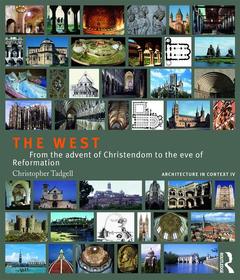Description
The West
From the advent of Christendom to the eve of Reformation
Architecture in Context Series
Author: Tadgell Christopher
Language: English
Subjects for The West:
Keywords
The West; The East; Antiquity; Modernity; Transformations; Reformations; Islam; Christopher Tadgell; European architecture; Otto III; 15th-century Italy; Henry III; Holy Roman Empire; Conrad III; art and architecture; Sancho III; ancient Rome; Edward III; Renaissance; National Library; Giuliano Da Sangallo; Christ Child; Frankish Kingdom; Tunnel Vault; Triumphal Arch Motif; Town Hall; Blind Arcading; Nave Arcade; Alfonso III; Julius II; Aisle Arcade; Rib Vault; Leo III; Bernardo Rossellino; Badia Fiesolana; Antonio Manetti; Stanza Della Segnatura; Cluny II
Publication date: 06-2017
· 18x21 cm · Paperback
Publication date: 05-2009
· 18x21 cm · Hardback
Description
/li>Contents
/li>Readership
/li>Biography
/li>
This volume tells the story of European architecture in the ?middle ages? ? from the destruction by northern barbarians of Rome and the urban society it had fostered to the rediscovery of Classical values and the rebirth of humanism in 15th-century Italy.
This period saw the evolution of feudalism, with its patterns of dependency and obligation, the establishment of monasticism in its varied forms, and the rise of the Holy Roman Empire. The art and architecture that emerged alongside this profound social reordering is known as Romanesque. Based on the legacy of ancient Rome, it included elements from Carolingian, Ottonian, Byzantine and northern European traditions. This synthesis produced some of its most powerful monuments in the glorious abbey churches that a period of prosperity and political stability fostered in unprecedented numbers.
Romanesque architecture was succeeded by the Gothic, a movement that originated at the abbey of S. Denis in France in the 12th century. Structurally daring, it heralded a new architecture of light, most enduringly expressed in great cathedrals, subsequently in the growing sophistication of houses and civic architecture as feudal magnates increasingly ceded power to the central authority.
The book ends with the Italian rediscovery of Classical ideas and ideals and the emergence of the great Renaissance theorists and architects, including Brunelleschi, Alberti and Bramante. As well as the palazzos, villas and churches of Renaissance Italy, this period saw the building of great châteaux in France, palaces in Germany and the golden-domed cathedrals of Russia.
With more than two thousand images, including many plans, The West is an unprecedented single-volume survey of the period, covering the whole of Europe from Ireland to Russia, and placing architectural developments within their political, technological, artistic and intellectual contexts.
Part 1: Renovation of Gravitas Prologue 1.1. Empire Regained and Relapsed 1.2. The Centre: Holy Roman Empire 1.3. The East: Towards the Third Rome 1.4. The West: Post Carolingian Diversity Part 2: Refraction of Light Introductions to the Gothic Age 2.1. Light Into Stone: The Gothic Cathedral 2.2. Secular Building in the Gothic Age Part 3: Revival of Classicism Introduction 3.1. Cataclysm and Classicism at Large Epilogue: From Medieval Towards Neo-Classical Abroad Conclusion Glossary Further Reading Index
Christopher Tadgell taught architectural history for almost thirty years before devoting himself full-time to writing and research, travelling the world to see and photograph buildings from every tradition and period.
Born in Sydney, he studied art history at the Courtauld Institute in London. In 1974 he was awarded his PhD for a thesis on the Neoclassical architectural theorist, Ange-Jacques Gabriel. He subsequently taught in London and at the Kent Institute of Art and Design in Canterbury, with interludes as F.L. Morgan Professor of Architectural Design at the University of Louisville and as a Member of the Institute for Advanced Study, Princeton. He has lectured at academic institutions around the world, including the universities of Princeton, Harvard, Columbia and Cornell, the Graham Foundation in Chicago, and Cambridge University and the Courtauld Institute in the UK. He is a Trustee of the World Monuments Fund, a Fellow of the Society of Antiquaries and a member of both the British and American Societies of Architectural Historians.
His The History of Architecture in India (1990, several reprints, Phaidon) is the definitive one-volume account of the architecture of the subcontinent, while many publications on French architecture include the standard account in Baroque and Rococo Architecture and Decoration (ed. Blunt, 1978, Elek). He has contributed many articles on Indian and French architecture to The Grove Dictionary of Art and other major reference books.



